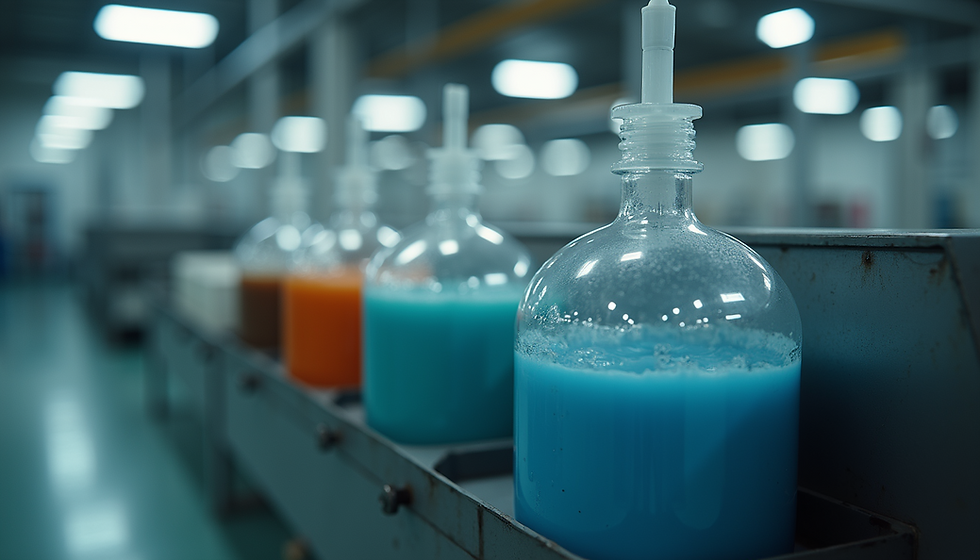Exploring the Role of Carboxylate Compounds in Modern Applications
- biofm9
- Aug 14
- 3 min read
Carboxylate compounds play a crucial role in various industries and scientific fields today. These compounds, derived from carboxylic acids, have unique chemical properties that make them valuable in everything from pharmaceuticals to environmental science. Understanding their applications can provide insight into how modern technology and industry benefit from these versatile molecules.
Understanding Carboxylate Compounds and Their Importance
Carboxylate compounds are salts or esters of carboxylic acids, characterized by the presence of the carboxylate ion (R-COO⁻). This ion forms when a carboxylic acid loses a proton (H⁺), resulting in a negatively charged species that can interact with metals or other positively charged ions. This interaction is the foundation for many of their uses.
These compounds are essential because they exhibit strong coordination abilities, making them useful in catalysis, metal extraction, and as intermediates in organic synthesis. Their solubility in water and other solvents also allows them to be used in various formulations, including detergents and pharmaceuticals.
Key Properties of Carboxylate Compounds:
Ionic nature enhances solubility in water
Ability to form complexes with metals
Stability under various chemical conditions
Versatility in forming esters and salts

Applications of Carboxylate Compounds in Industry
Carboxylate compounds have found widespread use across multiple industries due to their chemical versatility. Here are some of the most significant applications:
1. Pharmaceutical Industry
Carboxylate compounds are often used as intermediates in drug synthesis. Their ability to form stable salts improves the bioavailability and solubility of many medications. For example, sodium carboxylates are commonly used to create water-soluble drug formulations.
2. Agriculture
In agriculture, carboxylate compounds serve as chelating agents that help deliver essential micronutrients to plants. These compounds bind to metal ions like iron and zinc, making them more accessible to crops and improving growth and yield.
3. Environmental Science
Carboxylate compounds are used in wastewater treatment to remove heavy metals. Their ability to bind metals allows for the extraction and recovery of toxic elements, reducing environmental pollution.
4. Industrial Manufacturing
In manufacturing, carboxylate chemicals are used as corrosion inhibitors, plasticizers, and surfactants. Their chemical stability and interaction with metals make them ideal for protecting machinery and enhancing product performance.
For more detailed information on the variety and uses of these compounds, you can explore carboxylate chemicals.

What is an example of a carboxylate?
A common example of a carboxylate compound is sodium acetate. Sodium acetate is the sodium salt of acetic acid and is widely used in food preservation, as a buffering agent, and in heating pads due to its exothermic crystallization properties.
Another example is calcium citrate, which is used as a dietary supplement to provide calcium and as a food additive to regulate acidity.
These examples highlight the diversity of carboxylate compounds and their practical applications in everyday life.
Sodium Acetate Uses:
Food preservation and flavoring
Buffering agent in biochemical applications
Heat packs for therapeutic use
Calcium Citrate Uses:
Nutritional supplement for bone health
Food additive to maintain pH balance

How Carboxylate Compounds Enhance Sustainability
Sustainability is a growing concern in chemical manufacturing and product development. Carboxylate compounds contribute to greener processes in several ways:
Biodegradability: Many carboxylate salts and esters break down more easily in the environment compared to synthetic chemicals.
Renewable Sources: Some carboxylate chemicals can be derived from biomass, reducing reliance on fossil fuels.
Reduced Toxicity: Their use in metal chelation and corrosion inhibition can minimize the need for harsher chemicals.
For example, bio-based carboxylate compounds are being developed to replace traditional petrochemical-derived surfactants in detergents, offering effective cleaning with less environmental impact.
Recommendations for Sustainable Use:
Opt for bio-based carboxylate chemicals when possible.
Implement recycling and recovery processes for metal-carboxylate complexes.
Use carboxylate compounds in formulations that prioritize biodegradability.
Future Trends in Carboxylate Compound Research
Research into carboxylate compounds continues to expand, driven by the need for innovative materials and sustainable solutions. Some promising areas include:
Advanced Catalysts: Designing carboxylate-based catalysts for more efficient chemical reactions.
Drug Delivery Systems: Using carboxylate compounds to improve targeted delivery and controlled release of pharmaceuticals.
Environmental Remediation: Developing new carboxylate-based agents for removing pollutants from soil and water.
The ongoing exploration of these compounds promises to unlock new applications and improve existing technologies, making carboxylate compounds a key focus in modern chemistry.
By understanding the diverse roles and benefits of carboxylate compounds, industries can better harness their potential for innovation and sustainability. Whether in pharmaceuticals, agriculture, or environmental science, these compounds offer practical solutions that meet the demands of today and the challenges of tomorrow.







Comments